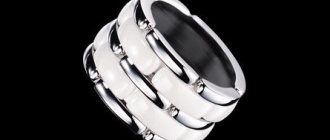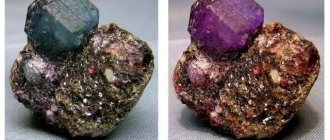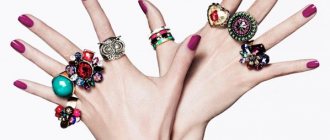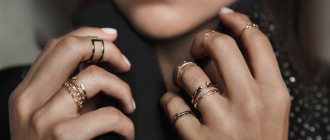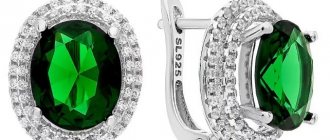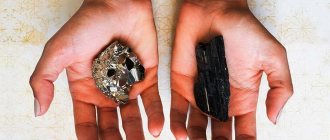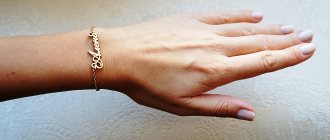Turquoise is an exquisite stone of soft blue color, endowed with truly magical properties. It has powerful energy, making turquoise ideal as a talisman or amulet, especially in combination with silver. The stone repels negative energy and helps spiritual development. But owners of turquoise jewelry should know how to wear them correctly and what is best to combine them with.
Story
Turquoise has a rich history. Five thousand years ago it was already known to people.
Early civilizations valued turquoise as a jewelry stone, and most importantly, as a symbol of the deity of Heaven. Among the Egyptians, it was a sacred attribute of Hathor, the goddess of love and joy; The Navajo Indians had a goddess Ahsonnutli (“turquoise woman”), while the Aztecs believed that wonderful stones were the tears of a heavenly goddess. And some myths claim that the bones of those who died from unhappy love turned into turquoise. Turquoise objects were found in Egypt in the tombs of Pharaoh Tutankhamun and Queen Zara.
Not only jewelry was made from turquoise, but also amulets and amulets. In Turkey, for example, the Janissaries decorated themselves, horses and weapons with turquoise for invulnerability. In Central Asia, it was an amulet for horses: it was believed that the rider would stay firmly in the saddle of a tireless and obedient horse.
This stone was also used for fortune telling, as it has the ability to change color and fade.
Turquoise has a special meaning among Muslims, since the Koran is inscribed on it.
This is the favorite stone of the Tatars. On the cap of the Kazan kingdom, which Ivan the Terrible ordered to be made for the last Kazan king Simeon (1552), there is a lot of turquoise.
Followers of Islam have a wedding custom: the bride and groom exchange rings carved from turquoise.
Boris Godunov's throne, delivered from Turkey, was decorated with light turquoise gems; they brought him peace of mind when thinking about state affairs.
In Europe, turquoise began to be called “Turkish stone”. The Persian name took root in Russia, and it could be translated in different ways:
- “firuze” - stone of happiness;
- “Piruz” is the stone of winners.
The second translation is a reminder of the Eastern belief that the gem grants victory in battle.
In our time, the gem has not lost its meaning for humans and has even expanded it. Many recognize the magical properties of turquoise and take a turquoise amulet into service, hoping that their work will be appreciated by their superiors. Turquoise helps investors make the right decisions, and writers help them gain popularity.
Characteristic
What does turquoise stone look like?
It is an opaque gem with a waxy sheen, green, or less often blue; There is also white turquoise. In addition to the main colors, there are various shades that create impurities of copper and iron. Brown spots are common. The structure of this mineral is not a crystal, but an agglomerate. It is soluble in hydrochloric acid, and if it is heated, it will turn brown and crack.
- Chemical formula: CuAl6( OH)2[ PO4 ] 4 H2O .
- Color - blue, blue-green, light blue, green, sometimes white, brown spots are often present.
- Impurities - copper, iron.
- The shine is waxy.
- Transparency - opaque.
- Hardness - 5–6.
- Cleavage - perfect/imperfect.
- The fracture is conchoidal and uneven.
- Density - 2.6–2.8 g / cm3 .
Good combination with red
The combination of turquoise and red is always bright and unexpected. If you want to look original, expressive, even extravagant, wear turquoise and red.
Stylists recommend mixing these shades in unequal proportions, making one color dominant or adding balancing white clothes to your look.
Colors and varieties
Turquoise is a stone that has three main colors, as well as their shades. Moreover, the color changes over time: a young stone is white or slightly bluish, and green turquoise is an old mineral.
Colors
The color range of the stone is extensive. It has a rich range of blues and greens; the pebble may also be blue-green.
Primary colors of turquoise:
- Blue. This subtle coloration is rare. This stone has sufficient strength, so jewelry is often made from it. The most popular are specimens of delicate blue. Shades can be the following: light blue, greenish blue and blue-blue.
Blue turquoise
- Green. Sometimes it is heterogeneous, there are dark veins. Chinese stone or old stone has this color. Popular in Mongolia and Tibet. Shade options: gray-green and light green.
Green turquoise
- White. This is a mineral that is just beginning to mature or just beginning to develop pigmentation. The structure is porous, so white turquoise is used very rarely for jewelry, but it is valued by collectors.
White turquoise
Varieties
Often there are light-colored stones with patterns visible on the surface. They are created through a combination of chromium, copper, iron, and manganese.
- Mesh turquoise (spider web, lace). Samples with brown or black veins, which, intersecting chaotically, create a beautiful pattern.
- Bone turquoise. This is dental or bone phosphate of fossil mammals. The color is turquoise. Used to imitate real stone. High-quality processed specimens are valued; They are rarely on sale. It is mined in the south of France and Siberia.
Turquoise is also classified according to its deposits:
- Arizona - sky blue, premium grade.
- Chinese - green variety.
The uniqueness of turquoise of any kind is the ability to live through 3 periods: youth, maturity and old age.
Turquoise blue combination
It is thanks to their affinity that these shades harmonize amazingly with each other, looking fresh. To create greater contrast and add luxury and aristocracy to your look, wear ultramarine blue trousers with a thin turquoise blouse and pair them with a small stylish clutch.
Medicinal properties
The healing properties of turquoise are valued by healers, healers, and lithotherapists. This mineral is capable of harmonizing both the body and the psychological state of a person, and can also serve as an indicator of health.
As for the last ability, it manifests itself in the fact that when the owner is ill, turquoise fades (due to increased moisture levels or temperature).
Turquoise helps with the following ailments:
- Insomnia (a pebble under the pillow will help, and it’s better if it’s set in silver).
- Weak immunity (it is advisable to wear turquoise in a gold frame or a gold bracelet with a gem on your right hand).
- Metabolic disorders (a stone in a gold setting will help normalize it).
- Headache, migraine (wear a necklace, beads).
- Diseases of the liver, gall bladder, gastrointestinal tract (long beads).
- Sore throat, cold (beads).
- Diseases of the thyroid gland (pendant).
- Stuttering (pendant, earrings).
- Jaundice (turquoise will help relieve the painful condition of people suffering from this disease).
Turquoise can heal wounds, remove traces of scars and even stop bleeding.
Contemplation of turquoise in the morning helps improve vision.
Using a gem for medicinal purposes does not mean refusing to follow the instructions of the attending physician.
Pale blue turquoise improves psychological mood, harmonizes emotions, cleanses and restores energy.
A dark blue gem, which is worn in a wallet or bag (that is, not on the body), will give a person confidence and relieve him of doubts that shake the psyche.
Magic properties
The magic of this gem became known several thousand years ago and is beyond doubt among modern esotericists. They highlight the main magical properties of turquoise:
- Protection from negativity. The amulet is a barrier to dangers and accidents. Protective properties also appear in military battles and travel. Children's amulets are popular in the East; they are also worn by women expecting a child. Adults wear rings and rings: they are convinced that turquoise will protect them from evil forces and bring happiness and good luck.
- Health indicator. When the disease occurs, the color of the mineral weakens, becomes less saturated, and its shine is lost. After recovery, the brightness of the colors returns. If the owner dies, the stone also goes out. After being transferred to another person, it restores its color and shine.
- Transfers its energy to the owner. This is expressed in the fact that turquoise, in contact with a person at the subconscious level, contributes with its energy to the discovery of new possibilities of his personality. The owner may experience increased intuition, the gift of foresight, creativity and inspiration.
- Indicates unfavorable changes in relationships with people. The changing color of the stone signals a possible quarrel and separation. It is believed that if the gifted turquoise turns pale, this indicates a decrease in the heart of the giver.
- Helps to remain faithful. It is believed that the magic of turquoise guarantees strong love if the stone is presented by a loved one. Jewelry with this gem is very desirable for a bride at a wedding. This stone is a symbol of true love. It brings happiness and reconciles spouses.
- Promotes the manifestation of leadership qualities. As a result, there will be an opportunity for career growth. The stone will protect you from mistakes, risks and miscalculations.
- Helps to display courage and boldness in character. For people in dangerous professions, turquoise is an effective talisman.
- Reacts to bad weather and human illness. In the first case, the mineral darkens and its shine is temporarily lost, and in the other case, the mineral becomes dull.
A ring or ring with turquoise can attract love, happiness, spiritual perfection, luck, prosperity and prosperity. But the magic of the stone helps only honest and kind people achieve this.
The gem tries to make its owner kinder, teaches him to forgive and not be vindictive.
Turquoise stones of different types have their own magical properties:
- Light colors bring peace, inner harmony, and hope for the best.
- The dark ones will help in choosing a life path and important decisions; pacifies temper and imperiousness; a person will easily adapt to new things and act confidently.
- Light green smoothes out emotions and gives the ability to successfully defend one’s opinion.
- Dark green can only be worn periodically.
- Blues promote family happiness and success in business. Such a gem presented as a gift signifies the sincerity of the giver.
- Baby blues are important for girls and young women. Such a stone is sure to be present in the wedding attire of Muslim women.
- Dark blue helps develop patience and perseverance.
- blue-green ones , as this is an attribute of magicians for communicating with the other world.
- Whites protect against dangers, acting as amulets for people in dangerous professions, as well as extreme sports enthusiasts.
Dark blue, almost blue turquoise has the most powerful magical properties.
Turquoise amulets and talismans relieve stress and fatigue and promote correct assessment of life situations.
Who is suitable according to their zodiac sign?
Astrologers advise choosing a stone of your own color according to your horoscope:
- Blue - Gemini, Sagittarius, Aquarius.
- Bluish-gray - Libra, Cancer, Capricorn.
- White - Aries, Pisces, Virgo.
- Green - Taurus, Scorpio.
Turquoise is not recommended for people born under the sign of Leo. The gem, wanting to help the owner, throws him off balance. A person will not be able to pay attention to a specific matter, and relationships with close people will become tense.
Turquoise will only benefit the rest of the zodiac signs.
- Aries. The turquoise talisman will give optimism and also restrain impulsiveness, so that after thinking carefully, a person chooses the right path in life. This will lead to success in overcoming difficulties.
- Calf. For him, turquoise is a lucky stone that can change life for the better, give inner harmony, and relieve outbursts of negative emotions. This will attract even more friends to the sociable Taurus. The ability to withstand any stress, both physical and mental, will appear.
- Gemini will be able to overcome some duality of character and thinking. With the help of a turquoise talisman, they will become consistent and persistent in achieving their goals, avoid misfortunes and find love.
- Cancer will become more balanced, consistent and confident in its actions. Turquoise will help him relate more easily to criticism and to real life in general.
- Virgo wear jewelry with turquoise all the time and advise wearing it when going on the road.
- Scales. Turquoise will be very useful for them, as it will give them self-confidence and reduce dependence on other people and their moods.
- Scorpion. His anger will decrease significantly, rationality and self-control will appear. All this will bring good luck in business and in your personal life.
- Sagittarius and turquoise are ideally compatible; the stone will have only a positive effect on the owner. Self-confidence will increase, and this will contribute to success in any field. Emotional stability will increase and, therefore, mental vulnerability will disappear.
- Capricorn will feel the help of the gem in gaining confidence, composure, accurately defining goals and the right path to it.
- Aquarius will become wiser, which will improve relationships with friends and loved ones.
- Pisces will become calmer, anxiety will disappear, and harmonious relationships will be established with others. If a stone is lost, then it is better not to look for it (there is no need to buy a similar one either), since loss means incompatibility of the energy of a person and the gem. So in this case, it is better for Pisces to buy another stone that suits their horoscope.
How to wear
Turquoise is a universal jewelry stone; it is suitable for women and men of any age. You just need to choose the right shade. Blue-eyed and green-eyed people should wear light-colored gems, while dark-eyed people should wear richly colored jewelry.
This is a sophisticated but democratic stone; it looks appropriate in a wedding or evening dress, or as “baubles”.
Green shades of turquoise go well with yellow metals, blue shades with white metals.
A silver frame will enhance the healing properties of this mineral, and jewelry set in gold will protect the owner’s immunity.
Jewelry with turquoise is aesthetically combined with lapis lazuli, pearls, amber, aquamarine and other colored stones (energy compatibility is discussed above).
The combination of blue and green gems, as well as yellow and white frames, in one outfit is undesirable.
Range
There are turquoise jewelry - beads, necklaces, frameless bracelets and turquoise jewelry - accessories in a metal frame.
The color range of the stone: from blue to brownish through blue, green, sea. Therefore, there is a suitable option for any type of appearance, taste and wardrobe.
Publicly available jewelry contains stabilized, enriched, restored or synthetic gemstones. Only the last option is considered a fake. Accessories with natural turquoise are made to order.
Various precious metals are equally good with the stone: silver, gold, platinum.
Jewelry with turquoise
The insert for rings, rings, earrings, and brooches is made into a cabochon. For pendants, links of beads, bracelets, natural fantasy forms are left.
Rules of care
Turquoise should be handled with care and protected from sharp objects to avoid scratches. Caring for it is not very difficult:
- Clean only with dry suede or soft cloth (flannel, wool, etc.).
Cleaning with soap and water, as well as under ultrasound or steam is prohibited.
- If the stone is very dirty, you can wash it in distilled water, but do not delay the procedure.
- Overheating and contact with steam, perfumes, cosmetics, and household chemicals should be avoided (from contact with them, as well as with cosmetics, the mineral turns blue or green; aniline dyes are suitable for color restoration).
- To maintain color saturation, the mineral can sometimes be lubricated with lamb fat.
- Before swimming, visiting the beach or swimming pool, jewelry must be removed.
- It is better to store turquoise separately from other jewelry, otherwise it may lose its magical properties or suffer physical damage.
Turquoise needs to be removed from the box from time to time, as it loves light, but fades in direct sunlight.
The mineral changes color as it absorbs sweat and odors.
How to distinguish from a fake
Turquoise is counterfeited by coloring molten glass, plastics, and earthenware. Odontolite (fossilized remains of animals) is also used as an imitation; it can only be distinguished by microscopic examination.
It is quite difficult to visually distinguish natural stone from fakes, but still some signs can help with this:
- Usually the size of a real mineral is no more than 0.5 cm .
- You need to know what turquoise looks like. It is opaque, matte, dense, rough, swollen, and there are no cracks. In addition, natural stone is heavy.
Counterfeits made of earthenware or glass have swellings that are clearly visible under a magnifying glass.
The plastic is very light, colored evenly, and looks smooth.
- If turquoise is easily scratched with a needle, the groove will not differ in color. If an unpainted layer appears, shavings form or the needle slips off the stone, then this means that this is a fake.
- The color on the turquoise bead and in the hole should be the same.
- A real mineral is difficult to chip.
- A hot needle will cause the turquoise to turn brown, the plastic will melt and a chemical smell will appear.
- If a pebble is dipped in alcohol and wiped, a stained napkin indicates a fake.
Important! The test is always carried out from the inside of the mineral so that it is not damaged. You should not test with heat, as the turquoise may crack.
There are specimens on the jewelry market that occupy an intermediate position between imitation and real stone:
Fortified turquoise is a medium-grade porous stone impregnated with epoxy resin, grease, or paraffin. Strength is increased, color is not changed.
Refined turquoise is a low quality, brightly colored specimen. They have a smooth surface, usually pink or apple green.
Reduced (pressed) is low-grade minerals ground into powder or crumbs that remain from processing high-grade stones. They are painted, glued and sent to the press. There are a lot of such stones on the market, they are not very expensive, unlike natural specimens.
An artificial mineral (nanoturquoise) is created in laboratory conditions, and only an expert can identify it.
What to wear with black beads
Ornamental stones (agate, jet, a variety of hawk's eye and others) have a noble black color. Black goes well with almost all color shades and perfectly accents their background.
The most common color tandem option is black and white. Suitable as an office option: a white blouse, a string of black beads, a black/navy jacket or blazer.
This is a win-win summer and winter option. On the one hand, the severity and nobility of black, on the other, the purity and freshness of white.
At a certain angle, black harmonizes with black without getting lost against its background. A good complement is tanned or dark skin.
Focusing on the choice of bead sizes or the shape of ornamental stones, the height, fullness and length of the neck, and the general proportions of the figure are taken into account. For example, massive round black beads or a necklace made of several strands of beads “under the neck” look ugly on a full and short neck.
Silver jewelry with spinel, agate and pearls
Price
The reserves of turquoise in the deposits are practically depleted, so it is quite expensive.
Factors influencing the price:
- origin;
- quality;
- coloring
The cost is reduced due to yellowness, pattern, spotting, porosity.
The price of 1 gram of solid stone is from 120 to 180 $ , that is, approximately 25 $ per carat .
Dense blue samples without veins and “networks” are most valued; their price is up to $30 per carat .
The cheapest jewelry is made from pressed natural turquoise.
Although the most valuable and popular turquoise is its rich “sky” color, there are individual examples of other shades that cost more (for example, Australian apple green or chalk).
Examples of prices in Russian online stores:
- beads - 490 rub. (for 1 piece) ;
- tumbling bracelet with “Turquoise” crumbs — 644 RUR. ;
- earrings— RUB 1,142. ;
- stone (sample) - 1,490 rubles. ;
- beads - 2,004 rub.
Jewelry value
Heavenly stone is the second name for the mineral turquoise. For the Islamic world, it is a symbol of purity and innocence, so it is impossible for a Muslim bride to dress without it.
Classified as a semi-precious stone. The most expensive is flawless blue turquoise from Iran or Arizona (USA). Cheaper are blue, green, with a greenish or yellowish tint. Decorators appreciate specimens with a mesh of black or dark veins.
The rulers of Iran own a unique collection of gems. A work of art - Firah Pahlavi Shahini tiara made of turquoise accompanied by diamonds.

